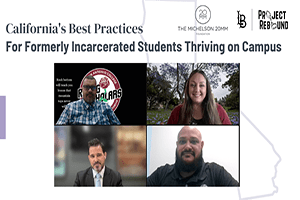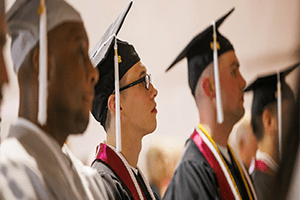Apr 5, 2023 | Smart Justice
By Kenia Miranda Verdugo
People leave prison with hopes of never having to return. As we learned in the beginning of the California’s Best Practices: Pathways From Prison to College series, the most proven way to end recidivism is through education. The educational system, however, struggles to adequately support the formerly incarcerated student population since sufficient data on who or how many formerly incarcerated students there are does not exist. Due to the lack of information, we fail to understand and address their specific needs in order to thrive on a college campus.
Most people exiting prisons and entering college are older than the rest of their peers and hold different responsibilities. Sometimes they have children and families to take care of, multiple full-time jobs, travel barriers due to parole, curfews, a parole officer they must respond to at any time, and more. Compared to many of their peers who entered college right out of high school, the responsibilities of formerly incarcerated students often go unnoticed by educational institutions, which results in a gap between their needs and the support they are given.
Throughout this webinar series, we learned about California’s Best Practices for students inside prisons, students transitioning from prison to campus, and students thriving on campus. Each phase of the pathway from prison to college has its own unique barriers, which the Best Practices seek to address, disseminate, and remove.
The final webinar of the series, which occurred on March 29, 2023, included a panel discussion with the following participants:
- Dr. James Binnall, Executive Director, Project Rebound California State University (CSU), Long Beach
- Jennifer Gomez, Program Coordinator, University of California (UC), Irvine Leveraging Inspiring Futures Through Educational Degrees (LIFTED)
- Dr. Joe Louis Hernandez, Director, Rising Scholars Mt. San Antonio College
- Hector Cervantes, Director, UC Irvine Underground Scholars
As formerly incarcerated students and individuals who work with recently released students, the panelists discussed the barriers they encountered in the educational system and how they worked through them.
“Once I understood that higher education was a hustle, just like the streets, and I had the skills already, it became easier to navigate higher education and create those connections, building those relationships with people,” Dr. Hernandez shared. “That’s really what higher ed is about: it’s a relationship and a transaction… I teach my students in a way that lets them know they already have the strength and knowledge because a lot of people are going to tell them they don’t, that they didn’t come prepared academically.”
Upon asking the panelists what resources have aided in accomplishing academic goals, there was a common theme in all of the responses: community. Building community gives a sense of home away from home and helps to empower and uplift. Gomez underscored the importance of connections and community in higher education. “It’s really important for an educational program to not only include the classes, the lecture, the professor, the textbooks, that type of education that they’re receiving, higher education includes…reaching out to mentors, it includes making connections with professors and that larger community.”
The makeup of the panel was unique in that every panelist has experienced incarceration and now helps other currently and formerly incarcerated students with academics, which lent itself to another theme: having representation in these educational spaces, or all capacities for that matter. It makes a huge difference to have someone with lived experience informing policies, creating curriculum, becoming professors, publishing research, etc. Representation with intent, however, is what creates change, people in those spaces must want what’s best for the community and advocate for the community as a whole as opposed to just for themselves.
One benefit of having formerly incarcerated individuals among staff and faculty members is the empathy and understanding they can provide to their students since they themselves know the barriers faced. For example, Cervantes recalled a time where a student paroled straight into on campus housing and their parole officer was attempting to get a keycard to enter their student dwelling—to which the housing program declined. The P.O. also kept referring to the student as the felon or convict and the housing program consistently corrected them by saying “our student.” “I’m glad that he can have some type of empowerment,” shared Cervantes. “Being here on campus and having someone push back against his P.O.”
As the discussion concluded, I asked the panelists what they wished that non-formerly incarcerated higher education staff and faculty knew. Dr. Binnall answered beautifully by stating that he wished more staff and faculty realized how bright and capable folks that have been involved in the carceral system are. There’s talk among staff and faculty about how formerly incarcerated folks are involved in administration roles and our panelists argued that they aren’t involved because these opportunities aren’t available to them. “I’m a big proponent of next one up, I don’t want to do this work forever, right? I want the next person to fill my role as a faculty member who’s formerly incarcerated,” Dr. Binnall expressed. “That needs to keep going. And I think if we’re gonna build, one of the things that is important is opening these positions up, whether it’s administration, whether it’s staff, whether it’s faculty, whether it’s directors, to folks with records, and show them that these are available pathways to them.”
We were also fortunate to have an engaged audience. One important theme, brought up by the attendees, was how Diversity Equity, and Inclusion (DEI) courses and curriculum on campuses should include justice-impacted individuals. Proposed name: JEDI (Justice, Equity, Diversity, and Inclusion). The California’s Best Practices series has taught us that justice-impacted students have unique needs, barriers, and also strengths—having this addition onto curriculum would benefit the entire student body, staff, and faculty, as a whole.
As the California’s Best Practices series comes to a close, we look forward to continuing to disseminate the Best Practices across the country through conferences, seminars, and briefings. We hope the Best Practices inspire policy makers to engage with the justice-impacted community with the goal of creating change. Some of the brightest minds in the country are sitting inside a prison cell and will eventually reenter society, let’s keep this momentum going.
If you would like to revisit the conversation, the California’s Best Practices series is available on our YouTube channel.
Please find the original story here.




